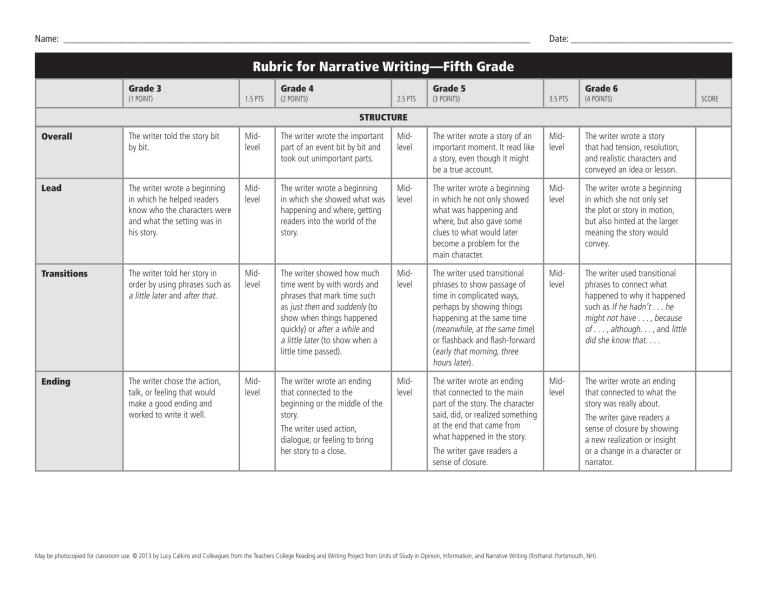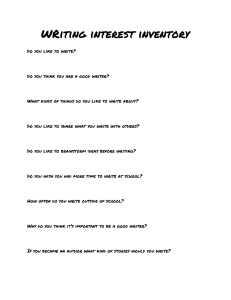
Name: ___________________________________________________________________________________________________________ Date: _____________________________________ Rubric for Narrative Writing—Fifth Grade Grade 3 (1 POINT) Grade 4 1.5 PTS Grade 5 (2 POINTS) 2.5 PTS Grade 6 (3 POINTS) 3.5 PTS (4 POINTS) STRUCTURE Overall The writer told the story bit by bit. Midlevel The writer wrote the important part of an event bit by bit and took out unimportant parts. Midlevel The writer wrote a story of an important moment. It read like a story, even though it might be a true account. Midlevel The writer wrote a story that had tension, resolution, and realistic characters and conveyed an idea or lesson. Lead The writer wrote a beginning in which he helped readers know who the characters were and what the setting was in his story. Midlevel The writer wrote a beginning in which she showed what was happening and where, getting readers into the world of the story. Midlevel The writer wrote a beginning in which he not only showed what was happening and where, but also gave some clues to what would later become a problem for the main character. Midlevel The writer wrote a beginning in which she not only set the plot or story in motion, but also hinted at the larger meaning the story would convey. Transitions The writer told her story in order by using phrases such as a little later and after that. Midlevel The writer showed how much time went by with words and phrases that mark time such as just then and suddenly (to show when things happened quickly) or after a while and a little later (to show when a little time passed). Midlevel The writer used transitional phrases to show passage of time in complicated ways, perhaps by showing things happening at the same time (meanwhile, at the same time) or flashback and flash-forward (early that morning, three hours later). Midlevel The writer used transitional phrases to connect what happened to why it happened such as If he hadn’t . . . he might not have . . . , because of . . . , although. . . , and little did she know that. . . . Ending The writer chose the action, talk, or feeling that would make a good ending and worked to write it well. Midlevel The writer wrote an ending that connected to the beginning or the middle of the story. Midlevel The writer wrote an ending that connected to the main part of the story. The character said, did, or realized something at the end that came from what happened in the story. Midlevel The writer wrote an ending that connected to what the story was really about. The writer used action, dialogue, or feeling to bring her story to a close. The writer gave readers a sense of closure. The writer gave readers a sense of closure by showing a new realization or insight or a change in a character or narrator. May be photocopied for classroom use. © 2013 by Lucy Calkins and Colleagues from the Teachers College Reading and Writing Project from Units of Study in Opinion, Information, and Narrative Writing (firsthand: Portsmouth, NH). SCORE Grade 3 (1 POINT) Grade 4 1.5 PTS Grade 5 (2 POINTS) 2.5 PTS Grade 6 (3 POINTS) 3.5 PTS (4 POINTS) The writer used paragraphs to separate different parts or time of the story and to show when a new character was speaking. Some parts of the story were longer and more developed than others. Midlevel The writer used paragraphs purposefully, perhaps to show time or setting changes, new parts of the story, or to create suspense for readers. He created a sequence of events that was clear. SCORE STRUCTURE (cont.) Organization The writer used paragraphs and skipped lines to separate what happened first from what happened later (and finally) in her story. Midlevel The writer used paragraphs to separate the different parts or times of the story or to show when a new character was speaking. Midlevel TOTAL DEVELOPMENT Elaboration* The writer worked to show what was happening to (and in) his characters. Midlevel The writer added more to the heart of her story, including not only actions and dialogue but also thoughts and feelings. Midlevel The writer developed characters, setting, and plot throughout his story, especially the heart of the story. To do this, he used a blend of description, action, dialogue, and thinking. Midlevel The writer developed realistic characters and developed the details, action, dialogue, and internal thinking that contributed to the deeper meaning of the story. (X2) Craft* The writer not only told her story, but also wrote it in ways that got readers to picture what was happening and that brought her story to life. Midlevel The writer showed why characters did what they did by including their thinking. Midlevel The writer showed why characters did what they did by including their thinking and their responses to what happened. Midlevel The writer developed character traits and emotions through what characters said and did. He developed some relationships among characters to show why they acted and spoke as they did. He told the internal as well as the external story. (X2) The writer made some parts of the story go quickly, some slowly. The writer included precise and sometimes sensory details and used figurative language (simile, metaphor, personification) to bring his story to life. The writer slowed down the heart of the story. She made less important parts shorter and less detailed and blended storytelling and summary as needed. The writer chose several key parts to stretch out and several to move through more quickly. * Elaboration and Craft are double-weighted categories: Whatever score a student would get in these categories is worth double the amount of points. For example, if a student exceeds expectations in Elaboration, then that student would receive 8 points instead of 4 points. If a student meets standards in Elaboration, then that student would receive 6 points instead of 3 points. May be photocopied for classroom use. © 2013 by Lucy Calkins and Colleagues from the Teachers College Reading and Writing Project from Units of Study in Opinion, Information, and Narrative Writing (firsthand: Portsmouth, NH). Grade 3 (1 POINT) Grade 4 1.5 PTS Grade 5 (2 POINTS) 2.5 PTS (3 POINTS) Grade 6 3.5 PTS (4 POINTS) SCORE DEVELOPMENT (cont.) Craft* The writer used a storytelling voice and conveyed the emotion or tone of his story through description, phrases, dialogue, and thoughts. (Continued) The writer included precise details and used figurative language so that readers could picture the setting, characters, and events. She used some objects or actions as symbols to bring forth her meaning. The writer wove together precise descriptions, figurative language, and symbolism to help readers picture the setting, actions, and events and to bring forth meaning. The writer not only varied his sentences to create the pace and tone of his narrative and to engage his readers, but also used language that fit his story’s meaning, for example, in parts that had dialogue, different characters used different kinds of language. The writer varied her sentences to create the pace and tone of her narrative. TOTAL LANGUAGE CONVENTIONS Spelling The writer used what he knew about spelling patterns to help him spell and edit before he wrote his final draft. The writer got help from others to check his spelling and punctuation before he wrote his final draft. Midlevel The writer used what she knew about word families and spelling rules to help her spell and edit. She used the word wall and dictionaries when needed. Midlevel The writer used what he knew about word families and spelling rules to help him spell and edit. He used the word wall and dictionaries when needed. Midlevel The writer used resources to be sure the words in her writing were spelled correctly. * Elaboration and Craft are double-weighted categories: Whatever score a student would get in these categories is worth double the amount of points. For example, if a student exceeds expectations in Elaboration, then that student would receive 8 points instead of 4 points. If a student meets standards in Elaboration, then that student would receive 6 points instead of 3 points. May be photocopied for classroom use. © 2013 by Lucy Calkins and Colleagues from the Teachers College Reading and Writing Project from Units of Study in Opinion, Information, and Narrative Writing (firsthand: Portsmouth, NH). Grade 3 (1 POINT) Grade 4 1.5 PTS Grade 5 (2 POINTS) 2.5 PTS (3 POINTS) Grade 6 3.5 PTS (4 POINTS) Midlevel The writer used punctuation to help set a mood, convey meaning, and/or build tension in his story. SCORE LANGUAGE CONVENTIONS (cont.) Punctuation The writer punctuated dialogue correctly with commas and quotation marks. While writing, the writer put punctuation at the end of every sentence. Midlevel When writing long, complex sentences, the writer used commas to make them clear and correct. The writer wrote in ways that helped readers read with expression, reading some parts quickly, some slowly, some parts in one sort of voice and others in another. Midlevel The writer used commas to set off introductory parts of sentences, such as One day at the park, I went on the slide; she also used commas to show talking directly to someone, such as Are you mad, Mom? TOTAL Teachers, we created these rubrics so you will have your own place to pull together scores of student work. You can use these assessments immediately after giving the on-demands and also for self-assessment and setting goals. Scoring Guide In each row, circle the descriptor in the column that matches the student work. Scores in the categories of Elaboration and Craft are worth double the point value (2, 3, 4, 5, 6, 7, or 8 instead of 1, 1.5, 2, 2.5, 3, 3.5, or 4). Total the number of points and then track students’ progress by seeing when the total points increase. Total score: ________ If you want to translate this score into a grade, you can use the provided table to score each student on a scale of 0–4. Number of Points 1–11 11.5–16.5 17–22 22.5–27.5 28–33 33.5–38.5 39–44 Scaled Score 1 1.5 2 2.5 3 3.5 4 May be photocopied for classroom use. © 2013 by Lucy Calkins and Colleagues from the Teachers College Reading and Writing Project from Units of Study in Opinion, Information, and Narrative Writing (firsthand: Portsmouth, NH).



